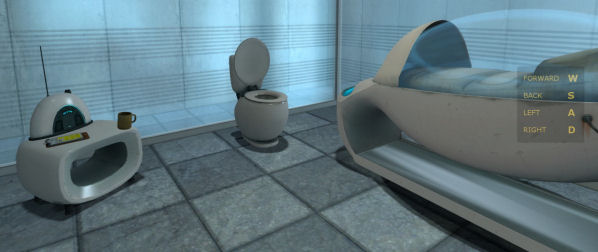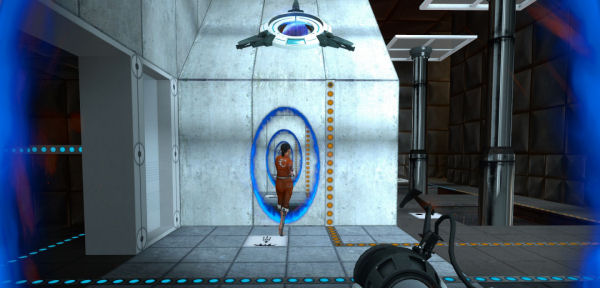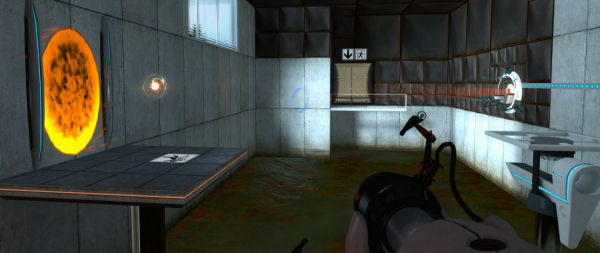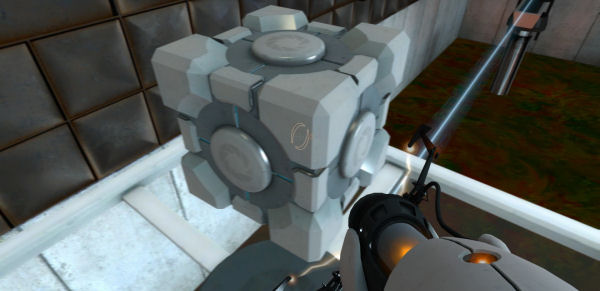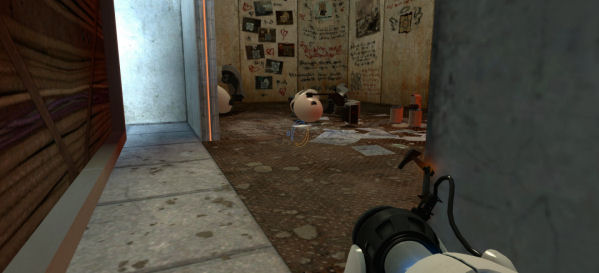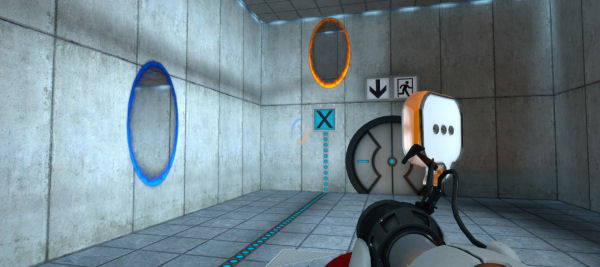RPS Verdict: Portal
Concept: A gun that shoots holes in the fabric of reality. Fire once to create an ‘in’ hole, and again to create an ‘out’ hole, enter one, and exit the other.
Application: A puzzle game, obviously. Elaborate obstacle courses only traversed via this dimensional manipulation.
Execution: Mellifluous.
Hello? Can I Help You?
The fairytale story of how Portal came into being has all but entered into legend. A plucky group of Digipen paupers created a final year project, Narbacular Drop, that was shown at the annual Digipen event for visiting developers. The handsome princes at Valve saw it, and liked it. Valve invited the team to visit their castle and demo their concept. Before they were halfway through their presentation, they’d all been offered jobs by the king. And then a couple of years later, a beautiful baby Portal was born. And we all lived happily ever after.
That the result – a first-person puzzle game compelling beyond reason, and funnier than you could imagine – came from a fledgling team on their first professional project is both testament to the talent within the group, and the remarkable nurturing environment of Valve. Portal is so evolved, so more elaborate and involving than anyone could have expected.
Not Never But NOW
The first hint that something peculiar is afoot would be the opening moment. You’re in a very small plastic cell, surrounded by a pharmaceutical white room, with little more than a bed, cabinet and a toilet for company. It doesn't feel particularly normal. It doesn't strike you as how most puzzle games begin.
The next hint would be the robotic sing-song voice of GLaDOS, an unseen over-watching voice, explaining that you’re about to begin training with the Aperture Science Handheld Portal Device. This is the gun that fires the portals, which you don’t have just yet. So once you’ve had a chat with the toilet, you make your way through your first portal to leave the cell. And you’re off. (Yes, that’s what we said.)
After trying to look at your own back via the portals – your character is a girl, with an unnervingly blank face, and a pair of peculiar leg braces below her knees – you make your way to the lift, and note the next clue that this isn’t your average puzzle game. The bleakly white lift is padded. This seems ominous. But at least there's the promise of cake.
The lift takes you to Room 1, where you’ll be taught the very basics of using portals. At this point your Aperture Science Handhel… your ASHPD can only fire one portal at a time, the other pre-placed in the room. Over the next couple of training rooms, you’ll learn how to manipulate this, and then eventually get a fully functioning portal gun, for fully functioning portal fun. Meanwhile, GLaDOS is getting weirder. And still promising you that cake.
In total there are 19 rooms, each advancing the difficulty in leaps and bounds. You aren’t stuck in the mire of a tiresome tutorial, but rather having your intelligence respected, as it asks you to think beyond what you’ve already learned and make the next intuitive leap. And each room is precisely designed to provide you with all the information you need, only ever obscured by your own lack of inspiration.
If you were to be sat down in front of, say, Room 17 having never played the game, you’d not stand a chance. It would be blisteringly difficult, and too daunting to try. Taking into account Portal’s brevity – easily finished in under three hours, and possibly closer to two for the clever-clogs – Room 17 is challenging, but relatively intuitive by the time you reach it chronologically, and this Portal’s greatest achievement. It’s a shining beacon of how to build a difficulty curve, never leaving you impossibly frustrated, but always demanding more of you, requiring experimentation based on acquired knowledge.
Toward the end you’ll be almost nonchalant in your manipulation of the space-windows to create acceleration and propel yourself across obstacles – something that but an hour and a half ago would have been impossible for your brain to consider, let alone execute.
Courage Is Not The Absence Of Fear
Were Portal to leave things there, with a brand new (if you don’t count Narbacular Drop) gaming mechanic, and a series of near-perfect puzzles, it would be something fairly special. But there’s so much more happening in here.
GLaDOS, to name it. She’s voiced by the utterly excellent Ellen McLain – a trained soprano who has appeared a few times before in Valve games. She’s the voice of the Overwatch in HL2 and Episode One, and – amazingly – the stern British woman barking announcements at you throughout TF2. This lady has range. GLaDOS’ synthesised voice carries a gentle melody that is at once alluring and threatening. And always hilarious. With each new room, her instructions become more peculiar, almost unhinged, as it becomes quickly apparent that she’s messing with your head. She doesn’t seem to like you very much, and she seems a bit too keen to point out the deadly nature of the brown goo on the floor of some rooms.
The script is written by a former half of Old Man Murray, Erik Wolpaw (in collaboration with the Portal team, and anyone else at Valve who piped up), and is quotably brilliant. I’ve been living in a hellish prison for the last two weeks since playing it, unable to bellow out favourite lines at everyone I meet. Come this blessed day I am freed, and able to jump up and down in people’s arms, blabbering on about how I’m in love with the Companion Cube, or offering them cake. It’s safe to say there’s not been a puzzle game that’s had that effect on me before.
Furthermore, everything has personality, right down to an inanimate plastic block. Best of all of these are the turrets. Despite their smooth, white-plastic design, they’re essentially the same as turrets you might have seen in the Half-Life games: incredibly deadly, but very vulnerable to being knocked over. Except now they talk. In beautifully cute melodic voices. “I don’t hate you,” sang a turret to me after I rendered it useless. “No hard feelings,” modulated another. “I don’t blame you,” chanted a third – particularly haunting.
The use of the Source engine, and the similarity of the turrets, is not the full extent of the game’s connection to the Half-Life universe. You'll recognise the energy orbs from Episode One, along with other familiar, perhaps even iconic furniture. Quite how it’s connected to the larger universe is a matter of personal interpretation of the events. Valve aren’t saying. But rest assured that if the FPS cousin doesn't interest you, it never stops being a pure puzzle game, with just the one ‘gun’, and the tight 19 levels.
I Thought The Cube Would Last Forever
It’s easy to be disappointed by Portal’s brevity. Just when you’re feeling like the master of the tool, it’s over. While the story is complete, and the ending is the funniest gaming moment in many years, there’s no denying you’re left still hungry. It gives you a bite of a delicious cake, but then doesn’t let you gorge until stuffed. Fortunately there’s more to do once the main game is over. Six of the rooms can be replayed on a significantly higher difficulty level, and there are specific challenges for the regular levels, completing them either in a limited number of footsteps, a restricted number of portals, or a rigid time limit. These offer a terrifying challenge, with Bronze awards in reach, but Silver and certainly Gold seeming madly impossible. At first.
The advanced levels say something significant about the game. These are essentially the same as the original version, but with your previous means of completing them blocked. So perhaps you succeeded by toppling turrets with a cunningly placed portal. Now the turrets might be in protective cages, impossible to damage. Or the ledge on which you shot the necessary propelling portal exit? Covered in a portal-protected surface. You have to improvise further, manipulate the environment more elaborately, and with more cunning. And best, you could have completed the level this way the first time, but you’d never have thought of it.
Less defensible is the rather glum look to many levels. The once white walls are contrasted by dark brown anti-portal tiles, and the only colour on offer is that of your blue and orange meta-doorways. It’s highly stylised, and creates the sterile atmosphere the game desires, but it’s nevertheless a little dull.
It’s hard to find fault elsewhere. It’s telling that having played through both Episode Two and Portal, it’s Portal that I’ll be leaping onto first when everything unlocks. Episode Two is the superior, if we’re being so crass as to compare two wildly different games, but it’s a solid, linear narrative that I’ve joyfully experienced very recently. Portal I still have to defeat - those Silver and Gold challenges mocking me.
This is Valve’s trademark knowledge of the player put into a new genre. Because it knows how you’re going to think as you walk into a room, it is once more manipulating you, both to aid and hinder, such that when listening to the commentaries on a second run through, you’ll feel like the marionette of some lunatic benevolent puppeteer. You thought you looked up at one point because you were inspired to by your own ingenuity. But no – they tricked you into it. The cads.
As the Half-Life games are a target for FPS developers to aim toward, Portal is the exemplar for puzzle design. Every apparently simple object, every room layout, every crazed comment from your pathological guide, is tailored with ruthless precision to push you forward, keep you thinking, and challenge you further. It's short, but it's sweet like a gateau.
An Angel Visited This Gray Path
Don’t think of this as an extra bonus content in The Orange Box. This is a game worthy of sitting alongside Episode Two and Team Fortress 2, as well as Episode One and Half-Life 2. It’s brief – possibly too brief. But it’s magnificent. And so, so funny. I’m not going to mention it, but when you’ve finished the game you’ll know what I’m not mentioning right now. It’s something so special that this allusion is specific enough for those who know. So for goodness sakes, go play it so we can share the happiness.
Don't forget our Half-Life 2 Episode Two verdict. There's also plenty more (spoiler free) pics in our Portal Screenshot Gallery. Please note, don't post any spoilers in the comments thread below. Anything even vaguely spoilery will disappear - there will be plenty of time for discussing it all once everyone's had a chance to experience it for themselves.


